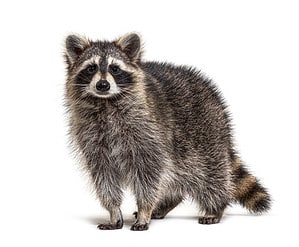Are raccoons nocturnal or diurnal? Raccoons are somewhat controversial characters. Some people find these furry mammals cute and cuddly; others regard the species as a pest. Raccoons are known to have relatively large brains yet somewhat limited social skills. They are primarily solitary animals, with the male especially often sleeping alone. Let’s take a closer look at these fascinating animals by examining their waking and sleeping cycles.
Raccoons are Nocturnal
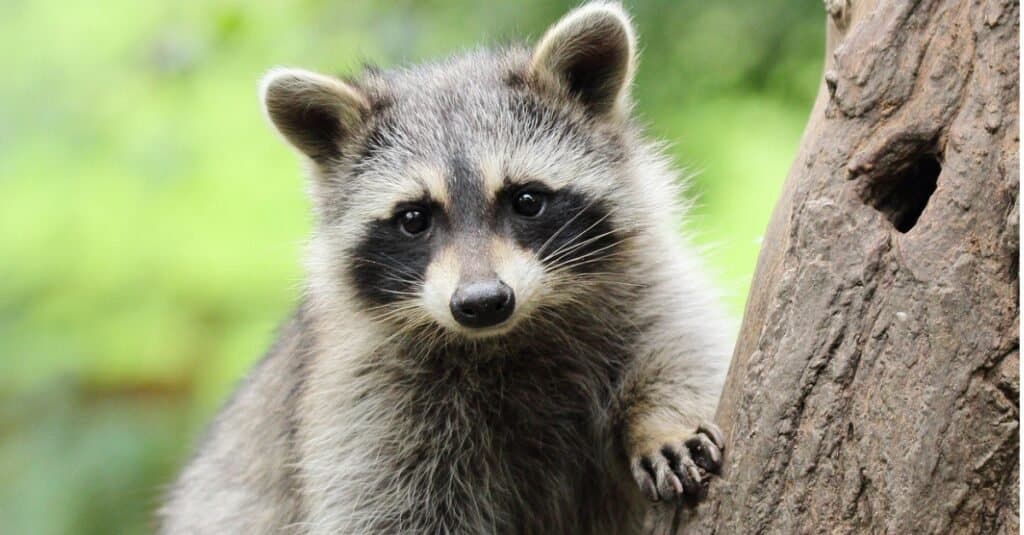
Most raccoons are nocturnal, but some can exhibit crepuscular behavior.
©iLUXimage/Shutterstock.com
Raccoons are nocturnal animals. They may venture out during the twilight- crepuscular- hours, but nighttime is undeniably their prime time. This time of the day is when they forage, scavenge and eat. Studies also confirm that raccoons are most adept and comfortable in darkness. They are also very aware of the moon and its phases. A clear moon casts light, which represents both threat and opportunity. So it shouldn’t be a surprise to learn that these intelligent animals are extra alert during a full moon.
How do Raccoons See at Night?
Raccoon’s eyes are well adapted for nocturnal excursions. Their eyes have a protective layer, the tapetum lucidum, behind the retina. It acts as a mirror and reflects the light to help the raccoon see well in dark conditions. This mirrored layer sometimes causes raccoon eyes to glow when they reflect light from car headlights.
The raccoon’s most distinct feature is the black fur surrounding the eyes. This patterning gives them the appearance of wearing a Zorro-style mask. Popular wisdom suggests this mask acts to deflect glare to enhance both daylight and nocturnal vision. So, it is necessary to mention that raccoons are probably color-blind. However, this is not a serious handicap in their natural environment.
Are Nocturnal Eyes Different from Diurnal Eyes?
Nocturnal animals like raccoons possess a tapetum lucidum which reflects light. This light reflection is due to a minimum number of cone cells in their retina. Also, their eye structure ensures that they absorb light when necessary. Ultimately, this design means that while their eyesight during the day is poor, their nighttime vision is good. In contrast, diurnal animals possess good vision during daylight hours but poor night sight. This feature is because of a high level of retinal cones that enables them to see details during the light of day and colors.
When are Raccoons Most Active?
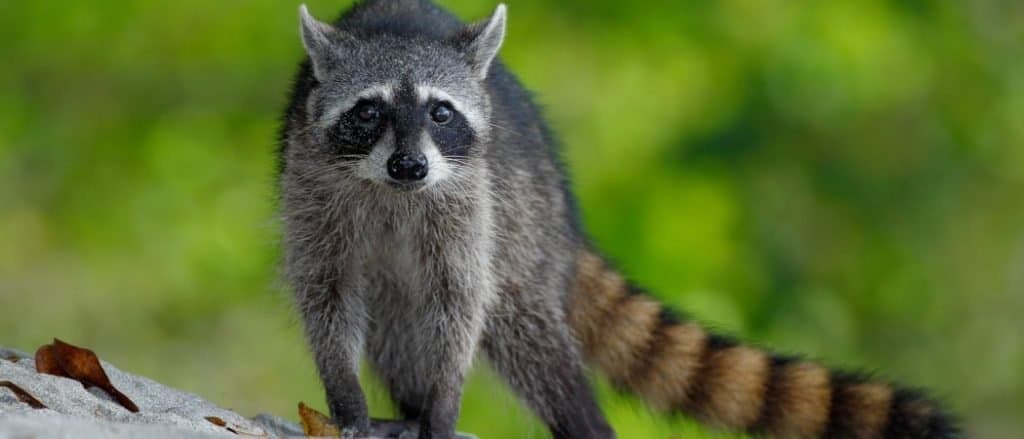
Raccoons are most active at night when they come out to feed.
©Ondrej Prosicky/Shutterstock.com
Raccoons are most active at night. They roam widely and energetically after darkness. Males can cover well over three square miles as they forage and hunt. Females cover slightly less ground, especially if they have young ones that need attention. Daytime sightings are not uncommon, but it is unusual for raccoons to be active for long periods during the day. They may pop out for an opportunistic snack. If their den is disturbed or threatened during the day, they will also act to protect it or move in search of alternative shelter.
Raccoon Activity and Feeding Behavior
Raccoons are expert and adept scavengers. In normal conditions, they seldom go hungry, and they definitely aren’t picky eaters. They eat just about anything on which they can lay their paws. Moreover, raccoons are omnivorous, so they eat both plant and animal foods. A raccoon’s plant diet might consist of nuts, berries, cherries, apples, corn, seeds, acorns, and fungi. Turning to animals, they eat rodents, rabbits, birds, and eggs. They also consume snakes, earthworms, snails, insects, and even carrion or roadkill.
Raccoons have sharp claws, perfect for tree climbing. These animals are also excellent swimmers. Besides, raccoons are athletic animals, able to trot and run on the soles of their feet and reach speeds of 15 mph. The five toes on the raccoon’s front paw are long, slender, and dexterous. Their sense of touch is excellent, helping them to detect and snag clams or crayfish from muddy or watery hides. Raccoons snatch birds and eggs from high nests or birdfeeders, making short work of their meal with sharp teeth. The masked bandit has no problem prizing open shells and handling delicate eggs with its flexible paws and claws.
Advantages of the Raccoon Being Nocturnal
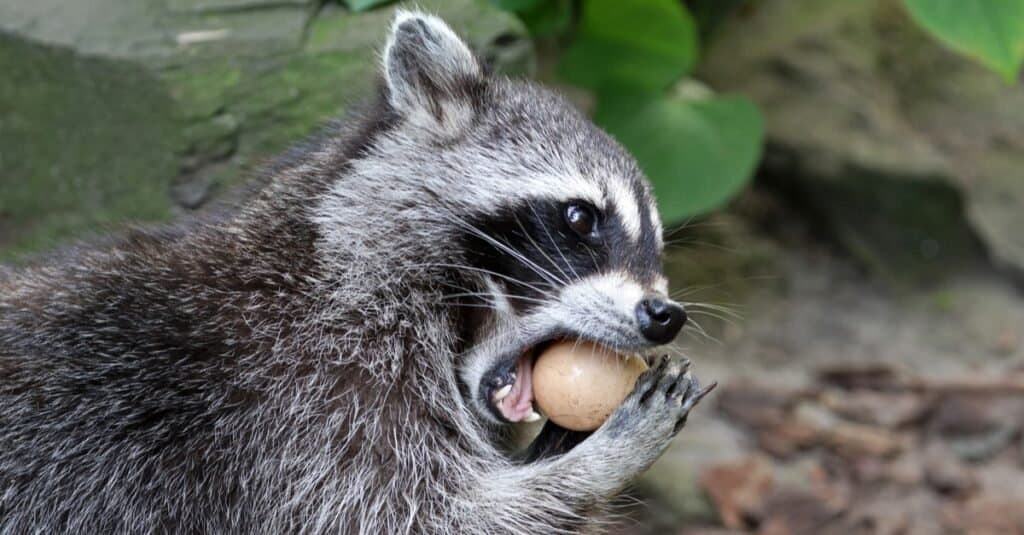
Hunting during the night allows raccoons a great choice of prey animals.
©iStock.com/Edwin_Butter
Raccoons are well adapted to nighttime conditions. Their natural body temperature is typically higher than that of diurnal animals. Their coloring is dusky in shades of grizzled, grayish brown. A dense underfur beneath their top coat provides further protection against chilly conditions. Raccoons have strong night vision and good hearing. Their excellent sense of touch makes them formidable foragers in the dark. They prey on other nocturnal animals and have a great selection of night creatures to target, ensuring they are almost always well-fed.
Disadvantages of the Raccoon Being Nocturnal
The raccoon has several natural predators like coyotes, bobcats, red foxes, and large birds of prey. Predatory birds like owls target smaller raccoons, for example. Most of these creatures are on the prowl between dusk and dawn. However, raccoons are expert tree climbers, which enables them to evade many of their predators. When threatened or attacked, raccoons will hiss, bite and scratch to defend themselves.
When and Where do Raccoons Sleep?
As dawn breaks, these nocturnal creatures become less comfortable. In daylight, they are more alert and skittish, and their eyesight is less sharp. So they retreat and lie low in safe places known as dens. Raccoons take shelter in tree cavities, riverbanks, brush piles, rock crevices, caves, old mines, hollow logs, and storm sewers. They like to be near trees and water and may establish more than one den. In their burrows, raccoons are safe from predators and can gather themselves for the night ahead. They use this period to sleep and rest and conserve energy.
Raccoon behavior is often opportunistic. Raccoons don’t root through garbage to deliberately create a mess. They see a trash can as a convenient snack dispenser. Similarly, raccoons will conveniently move into burrows or hides abandoned by other animals. They are also known as home invaders in the wild and suburbia. As a result, raccoons frequently occupy old beaver lodges and muskrat shelters. In cities and towns, they are found, inconveniently for the homeowner, in chimneys, attics, and under porches.
How Long do Raccoons Sleep?
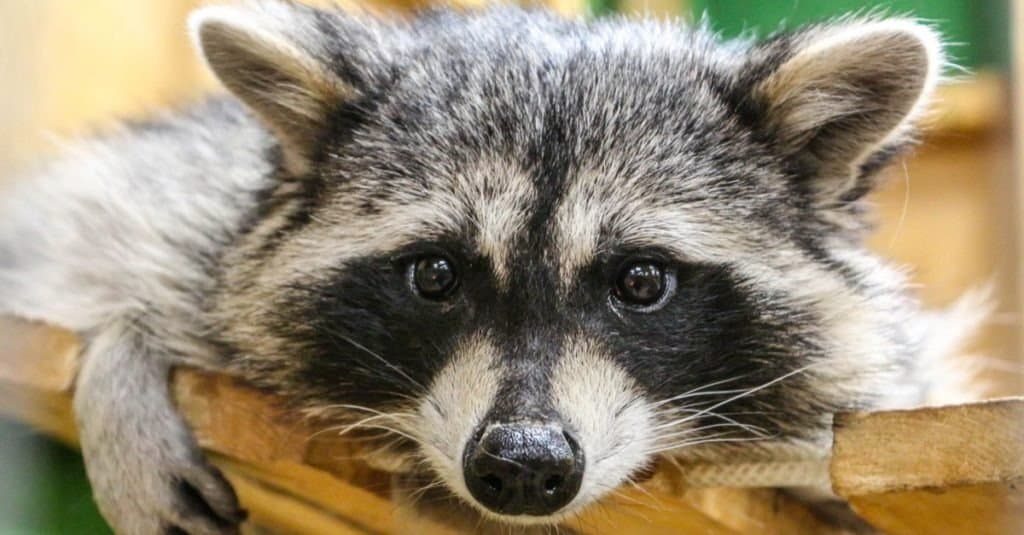
Raccoons spend around 6 to 8 hours per day asleep.
©O_Medvedeva/Shutterstock.com
Raccoons tend to sleep for 6 to 8 hours per day. The young and newborn will sleep for longer, with the mother guarding them closely. Young kits usually only leave the den for the first time between 8 to 12 weeks. Raccoons don’t hibernate but spend more time in their burrows during winter. They might shelter for weeks, only venturing out during milder spells. They prepare themselves for this phase by building fat reserves through extra foraging before the cold sets in.
This phase of relative inactivity coincides with the raccoon’s peak mating season from around January to March. Dens become scenes of increased socializing between males, known as boars, and females, known as sows. The gestation period is approximately 63 days. In April and May, the new season’s young enter the world. These babies don’t see their new surroundings until their eyes open at 3 to 4 weeks.
Do Raccoons Make Good Pets?
Some folks find raccoons so cute and cuddly they want to keep one as a family pet. Raccoons are curious and adaptive and comfortable living close to humans. But do they make good pets? Let’s recap a few of the animal’s main characteristics: sharp teeth and claws eat virtually anything, a messy scavenger, bites, and scratches, is not very social, needs space to roam, and is very active at night. There’s your answer. Raccoons are not easily domesticated and generally don’t make very suitable pets.
Nocturnal vs. Diurnal: What’s The Difference?
Navigate to Nocturnal vs. Diurnal: What’s The Difference? for further information about the nocturnal and diurnal phenomenon in various living creatures.
Up Next
The photo featured at the top of this post is © iStock.com/amadeusamse
Sources
- United States Department of Agriculture Animal and Plant Health Inspection Service, Available here: https://www.aphis.usda.gov/wildlife_damage/nwrc/publications/living/raccoons.pdf
- National Library of Medicine, Available here: https://www.ncbi.nlm.nih.gov/pmc/articles/PMC8128817/
- University Libraries and the Office of Research, West Virginia University, Available here: https://researchrepository.wvu.edu/cgi/viewcontent.cgi?article=2935&context=etd
- American Psychological Association, Available here: https://psycnet.apa.org/record/1962-00591-001
- Smithsonian Insider, Available here: https://insider.si.edu/2013/07/suburban-life-does-not-alter-solitary-ways-of-the-raccoon/
Thank you for reading! Have some feedback for us? Contact the AZ Animals editorial team.



